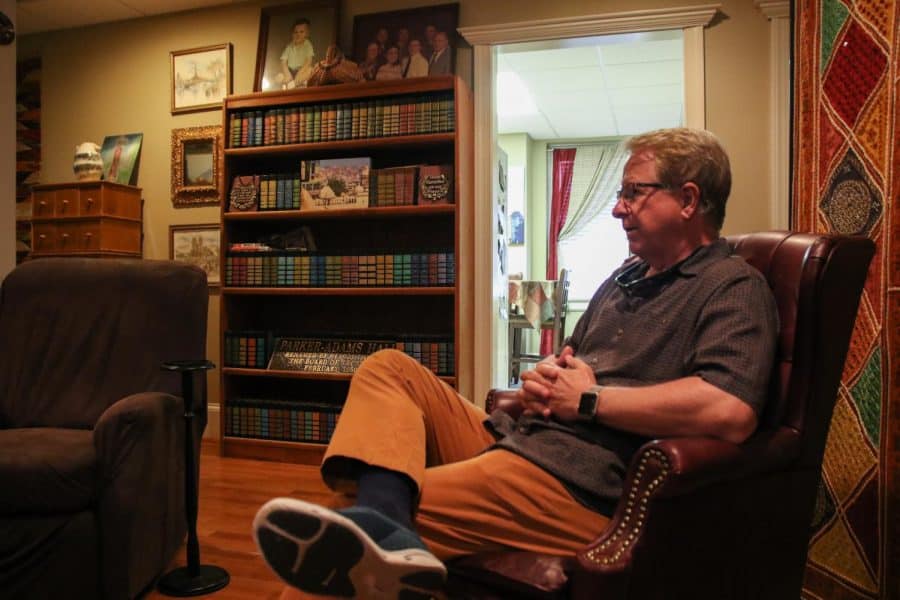On-campus staff engages residents outside of classroom
September 30, 2019
For years, the Faculty-In-Residence position has allowed staff members to continue their involvement with students beyond the classroom by living amongst them in the dorms. Whether they’re watching movies, playing games or doing community service, this opportunity serves both professors and students alike.
Since 1970, University of Alabama faculty have been encouraged to apply for a Faculty-In-Residence, or FIR, position on campus. Along with living in student housing for no cost, faculty members enjoy the convenient location and immersion into student life.
Sara Hughes, the assistant director of creative writing, is currently serving her first year as an FIR.
“I just moved in this summer,” Hughes said. “I already feel like I am more of a part of the UA community. I’m very aware of what’s going on around campus.”
There are 6 total FIR positions on campus at various dorms, and each year staff members must reapply to keep their spot. The application is open to any staff members, which makes this a competitive position. There is a three-year maximum that one can hold this position, unless in special cases.
Not only do FIRs live amongst the students, but they organize activities and events to get them socializing outside of their rooms.
“I’ve been hosting game nights in Ridgecrest South,” Hughes said. “Having staff members live on campus that run programming, that might even be slightly related to what they teach, creates a stronger sense of community amongst the students. It is a great way for them to de-stress.”
Hughes currently teaches an honors gaming class, so living around students was right up her alley.
“This is especially important in somewhere like RCS, where it’s apartment-style living and students could potentially only learn who their suitemates are and not meet other people,” Hughes said.
These students are not the only ones exposed to people they might not have met elsewhere. In fact, Hughes finds that this is one of the key features of the FIR position.
“I get to talk a lot with students I don’t teach, and that is the biggest difference between myself and a faculty member who doesn’t have this position,” Hughes said. “I want by the front desk every day, so I have really spent a lot of time talking to the students who work behind it.”
While these new interactions are an undisputed benefit to the position, Hughes can see where some may think it is too much.
“Some people would say that it could be hard to separate your personal and professional life,” Hughes said. “Nobody wants to feel like they have a 24-hour job, and it can kind of feel like that if you live where you work. I’m very aware that even when I am walking into Ridgecrest, I am a professor. When I see students, they are seeing me as a professor. I can’t really be fully myself until I’m in my apartment.”
Larry Bowen is a long-time FIR that dedicates most of his efforts to the Parker Adams freshman learning community for arts and sciences students. This program began in the 2000-2001 academic year, and Bowen has been a significant part of it ever since.
“We used to be based out of the Parker Adams building, which was knocked down in 2010 for sorority houses,” Bowen said. “That’s when we moved here, to Harris Hall.”
Harris Hall, located on Colonial Drive adjacent to the stadium, offers double-occupancy rooms with community bathrooms. While the hall’s study rooms and kitchens are convenient for students, Bowen appreciates the community room, where he is often seen chatting with students, despite the structural changes that have made this harder.
“In years past I’ve tried to sit out and interact with students, but it doesn’t work as well anymore,” Bowen said. “Then I would sit by the stairs where there was couches, but they got rid of those.”
When the Parker Adams students had their own building, a central community room connected the residential areas, and it was impossible to get anywhere without passing through it.
“It was total immersion,” Bowen said. “Now you can walk in the door and shoot up the stairs and never go near the common room. It’s not a central location like it was in our previous building.”
This obstacle has only made Bowen try harder and go out of his way for his students.
“I’ll walk around a lot and start a conversation or just sit on the porch sometimes,” Bowen said. “I’ll take a group out to lunch or something. We really emphasize cultural events too, so we go to the plays or dance productions. I love doing that kind of thing.”
Parker Adams students also have a mandatory four-hour study hall they must fulfill, and Bowen, a math instructor, would offer help to anyone who needed it. Even if the issue wasn’t academic, he is the one people turn to.
Rachel Underhill, a sophomore who participated in the Parker Adams program last year, appreciated the efforts made by Bowen, or “Dr. B” as they call him, to engage students beyond the classroom.
“Once every two weeks we would have a movie night in Dr. B’s apartment or play board games in the community area and just talk about how freshman year is going,” Underhill said.
The convenience of having a faculty member like Dr. Bowen around was something students took advantage of.
“He was around for anything, at any hour,” Underhill said. “He would answer emails at 3 in the morning or tutor anyone in math. I know kids who lived in Harris that would knock on his door asking for milk. It was things like that. He is so giving.”
Dr. Bowen still keeps in touch with his students that have graduated from the University. He has attended weddings of students that met in his class and even had former students name their twins Parker and Adam in the program’s honor.








